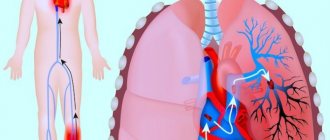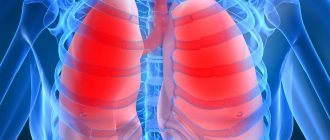Dangers
Do not forget that the provocateurs of such ailments are viral infections that require the correct approach to treatment. If the disease has not been completely cured, then the pathogenic microbes are not killed, but continue to spread throughout the body, eventually affecting the heart muscle.
The danger of this scenario is that even if heart pain occurs, many patients are in no hurry to see a doctor. The symptoms are attributed to overwork or nervous tension.
Many patients who have recently had a cold experience heaviness in the chest, difficulty breathing and other unpleasant symptoms. But only a few can connect pain in the heart after an acute respiratory viral infection and a respiratory infection.
A study conducted by the Texas Science Center showed that a patient's risk of having a heart attack with the flu increases by 30%. Infection and virus can lead to intoxication of internal organs. Such conditions require the body to work in an intensive mode, as a result of which there is a danger of heart disease.
Most patients experience the following changes in the heart during a cold:
- presence of dull tones;
- tachycardia.
In the case of sore throat, complications are also possible. It is not for nothing that this disease is treated with antibiotics and requires bed rest. By carrying it on your feet, the patient significantly risks his health.
Rarely, yes accurately – severe exacerbations
Fortunately, they don't happen that often. Knowing their characteristic symptoms can save your life, as they leave their mark on the heart, brain, kidneys, liver, adrenal glands and joints. Rare ones include:
- myocarditis and pericarditis;
- arachnoiditis;
- Reye's syndrome;
- glomerulonephritis;
- neuralgia.
Heart ailments. Myocarditis occurs only with the flu; a common cold can rarely penetrate the heart. The signs of the disease are subtle and difficult for the average person to detect. Pallor and irregularities in the heart appear due to impaired heart contractions. With pericarditis, fluid accumulates in the pericardial space, disrupting the functioning of the organ.
Cerebral complications are also his merit. ARVIs have no affinity for brain tissue. Signs of the disease appear 7-10 days after the peak of the flu. When the malaise subsides, the person suddenly feels very weak. A headache appears and the patient has a fever. The condition requires urgent hospitalization and long-term treatment.
Reye's syndrome is a disease predominantly of childhood. Its cause can be formulated as follows: flu + aspirin. With this syndrome, severe signs of liver damage develop, often requiring subsequent transplantation.
You need to bring down the temperature with paracetamol or ibuclin. Acetylsalicylic acid cannot be used.
Glomerulonephritis is an inflammation of the kidneys that appears 10-20 days after a cold. Its main symptoms are swelling, fatigue, and blood in the urine. The disease leads to serious consequences.
Colds and flu cause neuritis. Symptoms of neuritis are the following: pain along the nerve trunk, loss of sensitivity, dysfunction of the innervated muscles.
In ARVI, the facial nerve is most often affected.
Exacerbations are the result of neglecting one’s own health. Believe me, the world will not collapse if you lie in bed for a week. Allow your body to effectively fight infection.
Don't self-medicate! Make an appointment by calling +7 (499) 969-20-36 (for residents of Moscow and the Moscow region).
Source: infekc.ru
An epidemic of influenza, a viral infection, occurs almost every year, usually during cold weather, and affects about fifteen percent of the world's population. The largest number of severe cases of the disease, including deaths, are associated with complications from influenza. What are the complications and who most often develops them, says Galina Pavlovna Andrianova, assistant at the department of outpatient therapy and family medicine of the Krasnoyarsk Medical Academy.
Victims of influenza complications most often include people with poor health, young children and the elderly, as well as those who suffer from chronic diseases. That is, all those who have reduced immunity are the body’s defense mechanisms.
The influenza virus enters the body most often through air during breathing - this is an airborne infection, although household transmission is also possible, for example, through household items: linen, dishes, children's toys. Once inhaled, the virus lingers on the mucous membranes and infects ciliated epithelial cells. The physiological function of this epithelium is to cleanse the respiratory tract of dust, bacteria and other things. If the ciliated epithelium is destroyed, it can no longer perform its protective functions, and pathogenic bacteria easily penetrate the respiratory tract and lungs, where a secondary bacterial infection develops.
The virus then enters the bloodstream and spreads throughout the body. The epithelium of blood vessels is damaged, especially the smallest capillaries, whose permeability sharply increases. As a result, the cardiovascular system is affected, the hematopoietic and immune systems are inhibited.
Save your breath
Pneumonia is a complication after the flu. It is an inflammation of the lungs, and, as a rule, it is a secondary bacterial infection. Primary viral pneumonia, when lung tissue is infected by the influenza virus, is a rare complication with a high mortality rate. It develops in the first days or even hours of influenza infection - “fulminant” hemorrhagic pneumonia - and lasts no more than 3-4 days.
Acute bacterial pneumonia after influenza can develop in anyone. The bacteria attack part or all of the lung tissue, causing inflammation that includes chills, fever, difficulty breathing, and chest and side pain. In order not to miss a complication, the patient should be examined by a doctor; additional examination may be required: chest x-ray, ECG and the use of other techniques. The doctor will decide where the patient will be treated (sometimes hospitalization is necessary). This is why self-medication for the flu is unacceptable!
In addition to the lungs, secondary bacterial infection can cause inflammation in various parts of the respiratory tract. More often than others, rhinitis, otitis media, and bronchitis occur after the flu.
Rhinitis is a long-lasting, long-lasting runny nose, accompanied by copious nasal discharge, first clear, and then mucous, purulent and foul-smelling. It becomes impossible to breathe through the nose, as the swollen nasal mucosa closes the nasal passages. In the nasopharynx there is a feeling of dryness and soreness. Sneezing appears and the sense of smell sharply decreases. If rhinitis is not treated, inflammation spreads to the mucous membranes of the sinuses and ear.
Otitis is an inflammation of the ear. Bacteria can enter the ear from the nasopharyngeal mucosa. This happens especially often in children, due to the fact that the auditory tube connecting the nose and ear is much wider and shorter than in adults. A sign of external otitis - inflammation only in the auditory tube - is pain in the ear, which sharply increases with pressure on the tragus. The pain may be accompanied by itching in the ear and purulent discharge from the ear with an unpleasant odor. If the infection reaches the middle ear through the auditory tube and eardrum, otitis media develops - severe purulent inflammation with high fever, chills, and hearing loss. Otitis media also requires qualified assistance from an otolaryngologist.
Bronchitis is an acute inflammation of the bronchi. Bacteria are carried with inhaled air into the trachea and bronchi and infect their mucous membranes. The disease is characterized by a strong dry cough, which worsens in the morning, becomes annoying and debilitating, and sometimes mucopurulent sputum is released. Breathing becomes difficult - with shortness of breath. With an acute onset, fever, chills, and severe weakness develop. The situation is aggravated by smoking, including passive smoking. If you do not begin to treat the disease correctly, bacteria affect not only the mucous membrane, but also the deep tissues of the bronchial wall - then bronchitis becomes protracted and often becomes chronic.
Where it's thin, that's where it breaks
After the flu, complications associated with exacerbation of chronic diseases are often observed. This is due to decreased immunity as a result of infection. If a person suffers from chronic bronchitis, after suffering from the flu, as a rule, the process in the bronchi worsens, and if the patient has chronic pyelonephritis, an exacerbation of inflammation is observed in the kidneys. This applies to almost all severe chronic diseases, such as bronchial asthma, rheumatism, tuberculosis, metabolic disorders and other diseases. Complications of the cardiovascular system should be discussed separately.
During an influenza epidemic, the number of myocardial infarctions and cerebral strokes increases, because the influenza virus worsens the course of cardiovascular diseases, especially in the elderly and senile. But myocarditis (inflammation of the heart muscle) and pericarditis (inflammation of the pericardial sac) can also develop in people who have not previously suffered from heart disease. Sometimes the signs of these complications after the flu are not very noticeable: sometimes there is a tingling sensation in the heart, sometimes the heartbeat “starts”, sometimes “interruptions” - and all this against the background of general poor health. Flu without complications usually ends by 8-10 days. If, after the disappearance of all flu symptoms, severe weakness, decreased performance continues for a long time, shortness of breath appears with very little physical exertion, that is, signs of heart failure appear, it means that the heart cannot cope with its normal load as a result of viral damage. In order not to miss complications of influenza on the heart, medical supervision of the patient is necessary.
In severe cases of influenza, against the background of a very high temperature, signs of encephalopathy may appear - a complex of neurological and mental disorders: seizures, hallucinations, and others. Viruses can infect the tissue of the spinal cord and brain, causing inflammation - encephalitis, or inflammation of the membranes of the brain - meningitis. These are already complications of the flu.
How to avoid complications after the flu? Prevention is the best thing... not to get sick with the flu itself, and if you do get sick, under no circumstances should you self-medicate, or start taking the first antibiotics you come across. Flu cannot be treated with antibiotics! At the first symptoms of the flu, when the temperature rises, it is advisable to go to bed, take vitamin C and heart drops. If the temperature is very high - above 40 degrees (especially in a child), you need to call an ambulance. In other cases, you need to wait until the morning and call a doctor at home. Under no circumstances should you “be a hero”—go to the clinic yourself, infecting everyone along the way. I repeat once again - you need to call a doctor at home. And try to follow all his recommendations, including home remedies. It is impossible to predict the course of the flu. Only a doctor can correctly assess the patient’s condition.
Material prepared by Tatyana Popova
Source: kraszdrav.su
How does the flu affect the cardiovascular system?
Unfortunately, heart pain is not uncommon after the flu. And it may indicate the development of a number of pathologies. Influenza infection can have a negative effect on the heart muscle in the following ways:
- Influenza provokes the accumulation of fibrin in cells (this protein leads to blood clotting, and in large quantities can cause blood clots);
- As a result of infection, an increase in the concentration of cytokines is observed, which can cause dysfunction of the vascular walls;
- With an insufficient amount of oxygen, the heart begins to work harder, which can cause tachycardia and a number of other disruptions in the functioning of the heart muscle;
- As a result of ARVI, the normal functioning of the immune system is disrupted, which may result in cross-reactions. This leads to the possibility of developing immunity against the body's own cells.
- With the development of a bacterial infection against the background of influenza, the likelihood of inflammation of the heart muscle increases significantly. Streptococcal tonsillitis often leads to such consequences.
- The influenza virus is capable of disrupting the process of lipid metabolism, causing the appearance of atherosclerotic plaques.
- Even banal psychological stress that occurs against the background of viral diseases creates additional stress on the heart, creating favorable conditions for its subsequent damage.
Prevention of complications
The only possible way to avoid the flu altogether is vaccination, but it does not provide 100% protection against infection, since the virus mutates throughout the season.
Timely treatment, as well as rest, drinking enough, limiting stress, helps cope with the virus. To avoid dangerous consequences, you need to stop the development of inflammation.
The following remedies help support immunity when the body is working at its limit:
- Normal pH in the body is restored with the help of lemon, rose hips, and fruits.
- Supplements containing iodine reduce the activity of the virus.
- The antioxidant selenium destroys free radicals, reduces inflammation and the spread of infection.
- Magnesium chloride (bischofite) activates enzymes and immune cells to fight influenza.
- Vitamin C helps destroy pathogenic flora.
- Additionally, you need to breathe for 5 minutes per hour, using the diaphragm, so that air fills the lower sections of the lungs, which improves gas exchange and saturates the blood with oxygen.
What heart complications can the flu cause?
Flu is one of the most dangerous viral diseases. It causes heart complications more often than other similar diseases. In most cases, changes occur in the functioning of the myocardium, causing disruptions in the functioning of the entire organ. If treated incorrectly or incompletely, the influenza virus can penetrate into the deep layers of the heart muscle, provoking the development of an inflammatory process in it.
The most common complications of influenza are the following:
- myocarditis;
- heart failure in chronic or acute form;
- pericarditis.
Symptoms of heart pain after the flu depend on the specific disease. Therefore, the above diseases should be considered in more detail.
Symptoms of myocarditis
This disease is characterized by inflammation of the myocardium and appears a couple of weeks after the flu. Has the following characteristics:
- temperature rises;
- the body is weakened;
- the presence of dull pain in the sternum;
- lower limbs may swell;
- sweating;
- There may be heart failures that occur not only during physical activity, but also at rest.
If a patient develops these signs, he should immediately visit a doctor. With timely initiation of treatment, it is possible to completely eliminate the consequences of the disease.
Therapy for myocarditis is symptomatic. Antibiotics and anti-inflammatory drugs are widely used. Herbal medicines can be used as auxiliary medications.
Acute myocarditis requires bed rest and proper nutrition. After completing the treatment course, the patient must regularly visit the doctor for a year. If any abnormalities in cardiac function occur, you should immediately notify a specialist.
Pericarditis
The disease is characterized by inflammation of the serous membrane of the organ and rarely occurs as an independent disease. After the flu, the following manifestations of pericarditis are observed:
- deep breathing and shortness of breath;
- cardiac cough that occurs when changing body position;
- chest pain;
- weakness;
- dizziness.
With the rapid development of the disease, pressure surges and temperature increases also appear. The presence of these symptoms indicates the need for urgent hospitalization of the patient. If this is not done, the patient’s condition will constantly worsen, which may result in heart failure and unpleasant consequences.
In the most advanced stage, pericarditis leads to the onset of an inflammatory process in the serous membrane of the myocardium. This is accompanied by thrombus formation, which can pose a danger to the patient’s life.
If the therapy is selected correctly and treatment begins in a timely manner, the disease will completely recede within a couple of months. Proper diagnosis is very important, since the disease is often “masked” as other heart ailments.
Heart failure
This is a disturbance in the functioning of the heart, as a result of which there is insufficient blood supply to tissues and organs. The disease is characterized by symptoms such as:
- lethargy;
- sharp or aching chest pain;
- irregular heartbeat and increased heart rate;
- dyspnea;
- significant decrease in working capacity.
The development of the disease occurs due to the loss of the heart muscle’s ability to function normally. There are both acute and chronic course of the disease. Any form requires long-term treatment and medical supervision.
Flu and its symptoms
The infection spreads through the respiratory tract. Virus particles bind to epithelial cells, interacting with special receptors. The virus enzyme promotes the spread of infection in the mucous membranes of the nose, paranasal sinuses, pharynx, trachea, bronchi and alveoli.
After a typical incubation period of 48 hours, symptoms appear. The disease begins with severe fever, headaches, photophobia, chills, dry cough and sore throat, body aches. The temperature lasts for three days. The course of influenza depends on the strain of the virus.
Treatment methods
If a patient has heart pain after a cold, then he needs urgent treatment. Therapy is determined as a result of making an accurate diagnosis. In this case, the fate of the patient, his condition, the presence of pathologies and the degree of neglect of the disease should be taken into account.
The standard treatment regimen for this disease involves taking the following medications:
- Calming agents. Depending on the degree of the disease, both homeopathic and synthetic preparations can be used.
- Inhibitors.
- Diuretics.
- Adrenergic blockers.
- Drugs that improve metabolism.
- Glycosides that stabilize the functioning of the heart muscle.
In most cases, therapy is carried out in a hospital setting under medical supervision. This particularly applies to elderly patients.
Diagnostics
In order to prescribe the correct treatment for bronchitis that has arisen as a complication after the flu, it is necessary to promptly identify the disease and understand the specifics of its course.
Patients who notice the first signs of bronchitis should contact medical professionals. The specialist should prescribe the following measures to diagnose the disease:
- General examination - the attending physician checks the chest, listens to the lungs, and identifies the characteristics of wheezing
- Blood test - the procedure helps to identify characteristic signs of the inflammatory process, for example, an increased level of white blood cells
- Sputum analysis - allows you to identify the causative agent of the disease.
In addition, the doctor may prescribe additional forms of examination for patients to exclude other diseases:
- Chest X-ray – makes it possible to exclude pneumonia
- Spirography – designed to analyze the patency of the airways, allows you to exclude asthma
- Bronchoscopy is a procedure necessary to analyze the bronchial mucosa.
Preventive measures
To prevent the development of serious heart diseases, it is necessary to prevent colds. It involves the following measures:
- Vaccination. It is advisable to get vaccinated every year, since the vaccine is a remedy with proven effectiveness against ARVI.
- Hygiene rules. Very often, unwashed hands become the cause of various infections. Therefore, it is extremely important to carry out the necessary hygiene procedures before each meal. Outside the home, you can use special sprays or alcohol wipes.
- Taking antiviral drugs during epidemics can also significantly reduce the risk of developing diseases. It is advisable to consult a specialist regarding the most effective means.
- Having noticed the first symptoms of a cold, it is necessary to immediately begin therapy. Most drugs have the greatest effect during the first two days. To correctly identify the disease, you should consult a doctor who will determine the correct course of treatment.
If a person experiences heart pain due to ARVI, he needs bed rest and careful adherence to medical recommendations. For successful recovery and the absence of complications, proper nutrition and balanced sleep, as well as a competent medication regimen, are necessary. It is the last point that has one of the most important meanings. After the patient has received a prescription from the doctor, he must specify the following:
- What time of day is best to take the drug?
- Should it be taken before or after meals?
- How can you write down a medicine and what can’t you use it?
- What period of time should be observed between doses of drugs.
- Forgot to take your medicine in the morning: take a double dose in the evening?
- Is it possible to take pills on an empty stomach?
All these nuances greatly influence the effectiveness of the therapy. During the re-examination, the doctor should be informed about cases of drug withdrawal due to forgetfulness (if any have occurred), or about atypical reactions of the body that occur after taking the medication. This will allow the specialist to adequately assess the effectiveness of therapy and, if necessary, make its correction.
Complications that arise from ARVI often relate to heart diseases. And we are not talking about temporary illness, but about the development of serious illnesses that can significantly worsen the patient’s quality of life. Therefore, you should take the prevention and treatment of colds with all seriousness, reacting in time to changes in the body. And if you have heart pain after a cold, you should immediately consult a specialist.
Root Causes of Problems
For some people the planet is spinning too fast. They simply cannot afford to get sick. But in vain. ARVI and influenza suffered “on your feet” hold the record for the number of complications that arise.
Lack of treatment is reason number two. Vasoconstrictor drops and throat irrigators were invented for a reason. The risk of complications after consuming them is much lower.
But there are times when a person carefully follows bed rest and the doctor’s recommendations, but problems still occur. This situation is typical for people with immunodeficiencies and severe chronic diseases, especially the elderly and children under one year old. They are most at risk of severe infection.
The high mortality rate of influenza is due precisely to its complications, and not to the course of the disease itself.
The effectiveness of vaccinations
Vaccinations can have positive effects, but vaccines can also have negative effects. Today, the number of specialists who oppose the use of the vaccine is rapidly increasing. The harm of flu vaccinations lies in the likelihood of acute allergic reactions. Some patients complain of worsening symptoms of neuralgia between the ribs, as well as a decrease in hearing acuity and visual function.
Some doctors oppose vaccination because it can reduce the effectiveness of the immune system. Thus, the pathogen may become resistant to treatment if the virus is not defeated by the immune system. Moreover, the use of a vaccine in the presence of low immunity or immunodeficiency, on the contrary, can lead to a worsening of the disease or provoke a disease.
The disadvantage of vaccination is that there is no 100% guarantee after the manipulation. There is a risk that even a vaccinated person will get the flu and complications will occur. At the same time, stability of immunity does not come from the use of vaccination, since the virus is constantly mutating and new previously unknown strains appear that are resistant to certain drugs.
The vaccine is prepared on the basis of an old strain, and the virus that is widespread in current conditions may have a different genetic modification, so the body’s resistance will be minimal.
How is the scarlet fever vaccine given?
The flu is not so scary in itself, but its complications are dangerous. If you do not want to spend large sums of money and suffer from complications, it is worth preventing the flu from occurring, and if the body is affected, monitor your well-being and prevent a secondary infection from entering the body. In a medical institution, a diagnostic procedure is carried out, which will determine the true cause of the disease and allow you to create an adequate treatment regimen. Self-medication in this case increases the chances of complications from the flu and increased symptoms.
Source: SelectHealth.ru
Complications after colds and heart disease. What common?
In older people suffering from hypertension or coronary heart disease, against the background of a cold or after 3 weeks of illness, the symptoms of the underlying disease often begin to progress and may result in a heart attack or stroke. This happens because many viruses that cause acute respiratory infections are able to attach to the walls of blood vessels through which nutrients and oxygen enter the body. This can cause tissue hypoxia. Together with concomitant diseases (atherosclerotic plaques and vascular spasms), against the background of a cold, oxygen deficiency increases and disturbances in the functioning of the cardiovascular system worsen.
Complications can occur not only in older people, but also in practically healthy young people and children. The most serious of them are myocarditis, an infectious-inflammatory disease, and pericarditis, a process localized in the tissues that cover the outside of the myocardium. Symptoms can be completely different. These are general weakness, sweating, fatigue, cold extremities, shortness of breath, swelling, prolonged fever, chest pain and palpitations. Cough, abdominal pain and loose stools up to 5 times a day may also be present. Children, in general, may not experience any discomfort other than general weakness and fatigue.
Why do these diseases develop?
Most complications develop due to the following features of the infectious process with influenza:
- the virus has a toxic effect on capillaries;
- it is also capable of suppressing immune defenses;
- tissue barriers are disrupted during influenza;
- the composition and population of the microflora of the mucous membranes undergoes changes, which reduces the ability to resist the introduction of foreign microorganisms.
Thus, the influenza infection itself promotes infection by other microorganisms. However, complications do not develop with every episode of influenza. What is this connected with? It is believed that the likelihood of developing severe complications is much higher in such cases:
- pregnancy is a condition in which the immune system of the expectant mother is weakened (to prevent immunoconflict between mother and fetus);
- infancy is a period of life when the body has a hard time withstanding viral infections, since immune cells encounter viral pathogens for the first time, and the nervous and cardiovascular systems are very sensitive to changes in body temperature;
- the presence of concomitant diseases, including chronic ones (such as diabetes mellitus, heart defects, chronic respiratory infections), significantly increases the health risk of influenza infection;
- untimely initiation of treatment is fraught with more severe consequences of influenza;
- incorrectly selected treatment, non-compliance with rest, diet, refusal to take medications - all this significantly increases the risk of complications.










